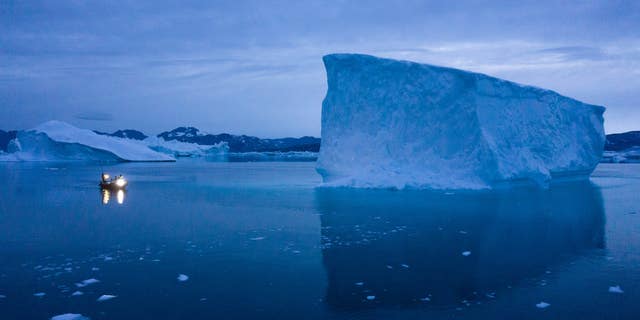NEWNow you can listen to the articles from Fox News!
According to a study released Monday, zombie ice from Greenland’s massive ice sheet will eventually raise global sea levels by at least 10 inches on its own.
Zombie or doomed ice is ice that is still attached to thicker areas of ice, but is no longer fed by those larger glaciers. This is because major glaciers are receiving less snow to replenish. Meanwhile, the doomed ice is melting due to climate change, said study co-author William Colgan, a glaciologist with the Geological Survey of Denmark and Greenland.
“It’s dead ice. It will melt and disappear from the ice sheet,” Colgan said in an interview. “This ice has been delivered to the ocean, regardless of the climate (emissions) scenario we take now.”
The study’s lead author Jason Box, a survey glaciologist in Greenland, said it’s “more like a foot in the grave.”
The Greenland ice sheet has reached the “tipping point,” says a disturbing study
The inevitable ten inches in the study is more than double the sea-level rise of what scientists previously expected from the melting of the Greenland ice sheet. The study in the journal Nature Climate Change said it could reach up to 30 inches. In contrast, last year’s report by the Intergovernmental Panel on Climate Change predicted a range of 2 to 5 inches for the likely sea level rise since Greenland ice melt by the year 2100.

The “zombie ice,” or ice that broke away from the glaciers that feed them, is pictured here in eastern Greenland on August 15, 2019, and could cause ocean levels to rise ten inches after melting.
(Photo AP / Felipe Dana, File)
What the scientists did for the study was to look at the ice in equilibrium. In perfect balance, the snowfall on the mountains of Greenland flows downward and recharges and thickens the flanks of the glaciers, balancing what melts at the edges. But in recent decades there is less supply and more melting, creating imbalances. The study authors looked at the relationship between what is added to what is lost and calculated that 3.3% of Greenland’s total ice volume will melt, regardless of what happens with the reduction in carbon pollution. around the world, Colgan said.
“I think starving would be a good phrase,” for what’s happening to the ice, Colgan said.
One of the authors of the study said that more than 120 trillion tons of ice are already set to melt due to the inability of the warming ice sheet to replenish its edges. When that ice melts into water, if it were concentrated only in the United States, it would be 37 feet (11 meters) deep.
This is the first time that scientists have calculated minimal ice loss – and consequent sea level rise – for Greenland, one of Earth’s two huge ice sheets that are slowly shrinking due to climate change due to combustion. of coal, oil and natural gas. Scientists used an accepted technique to calculate the minimum committed ice loss, the one used on mountain glaciers for the entire giant ice island.
THE ROCKS OF GREENLAND HAVE TRACES OF THE ANCIENT OCEAN MAGMA, SCIENTISTS DISCOVER
Pennsylvania State University glaciologist Richard Alley, who was not part of the study but said it made sense, said the committed melting and sea level rise is like an ice cube placed in a cup of hot tea in a warm room.
“You’ve made a mass loss from the ice,” Alley said in an email. “Likewise most of the world’s mountain glaciers and the edges of Greenland would continue to lose mass if temperatures stabilized at modern levels because they were released into warmer air just like your ice cube was put into tea. warmer”.
While 10 inches doesn’t sound like much, that’s a global average. Some coastal areas will be hit the hardest, and high tides and storms could be even worse, so this sharp sea level rise “will have huge social, economic and environmental impacts,” said Ellyn Enderlin, professor of geosciences at Boise State University. .
Time is the unknown key here and a bit of an issue with the study, said two outside ice scientists, Leigh Stearns of the University of Kansas and Sophie Nowicki of the University of Buffalo. The researchers in the study said they cannot estimate the timing of the disbandment committed, but in the last sentence they mention “within this century,” without supporting it, Stearns said.
Colgan replied that the team doesn’t know how long it will take for all the doomed ice to melt, but making an educated guess, it would likely be by the end of this century or at least by 2150.
GREENLAND LOST HUGE 600 BILLION TONS OF ICE LAST YEAR, SCIENTISTS WARN
Colgan said this is actually all a best case scenario. The year 2012 (and to varying degrees 2019) was a huge year of melting, when the balance between adding and removing ice was most out of balance. If Earth begins to experience more years like 2012, the melting of Greenland could trigger a 30-inch sea-level rise, he said. Those two years seem extreme now, but years that seem normal now would have been extreme 50 years ago, she said.
“This is how climate change works,” Colgan said. “Today’s outliers become tomorrow’s averages.”
